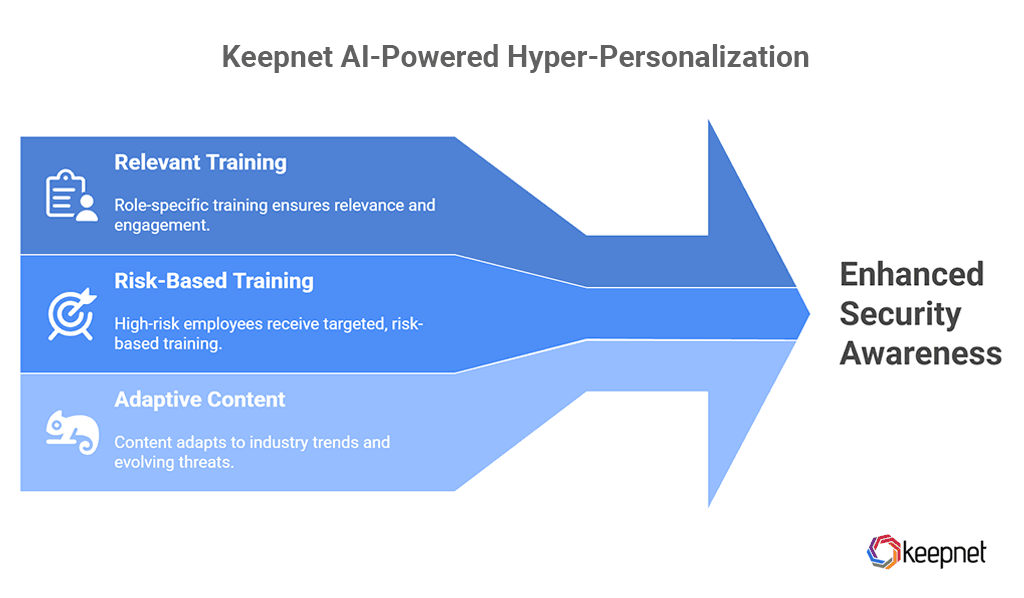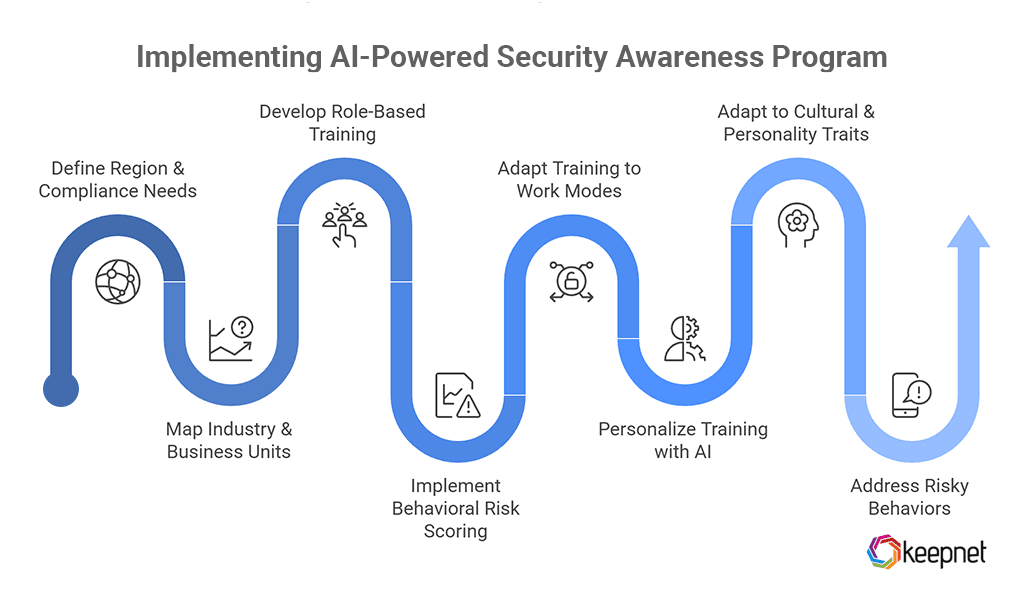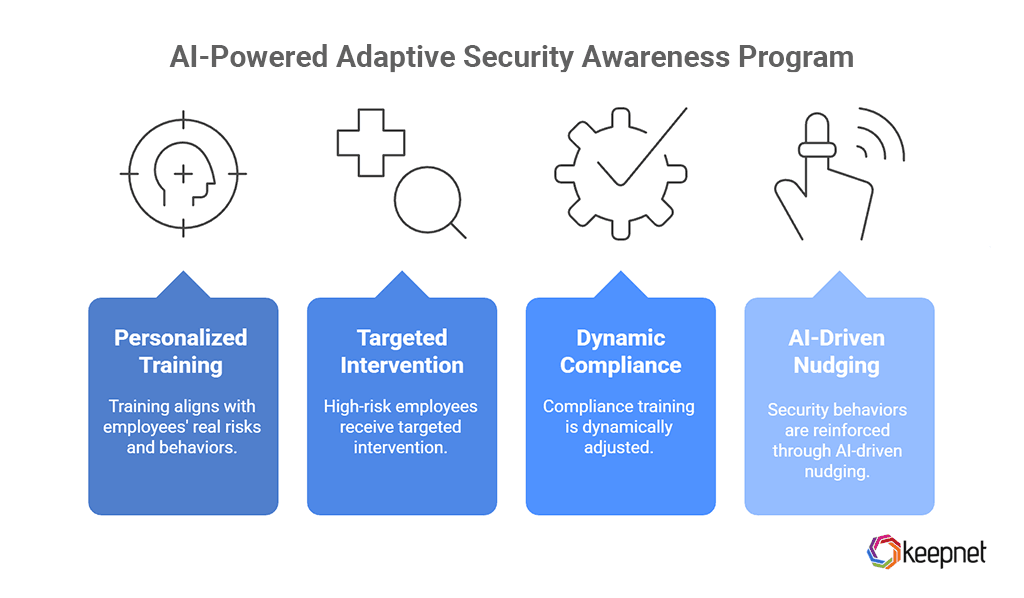AI-Powered Hyper-Personalized Security Awareness Program: A Strategic Guide for Organizations
90% of companies have security awareness programs, yet 70% of employees still show incorrect behaviors (Gartner). Traditional training often falls short. This guide explores AI-powered, hyper-personalized training tailored to roles and risks, driving measurable security improvements.
According to Statista, the cost of cybercrime continues to surge and might reach a staggering $15.63 trillion by 2029. Despite growing investments in security awareness, 70% of employees still exhibit risky behaviors after training (Gartner). This gap highlights the limitations of traditional security awareness training programs, which often fail to engage employees or address their unique risks. As cyber threats evolve, organizations need smarter, more adaptive solutions to build a resilient security culture.
In this blog, we’ll explore how AI-powered, hyper-personalized security awareness programs can transform your organization’s defense strategy. You’ll learn how AI tailors training to individual roles, behaviors, and learning preferences, leading to higher engagement, improved retention, and measurable reductions in security incidents.
The Challenge: Why Traditional Security Awareness Falls Short
Cyber threats are evolving rapidly, yet many organizations still rely on outdated, one-size-fits-all security awareness programs. These outdated approaches often result in low engagement, poor retention, and minimal behavior change. Employees receive generic training that doesn’t reflect their specific risks, making building a strong security culture difficult.
The stakes have never been higher! Cybercrime is projected to cost $12 trillion in 2025 (Source: Forrester), so the urgency of action is clear. SMEs, Enterprises, and Governments are grappling with increasing regulatory requirements and expanding attack surfaces. Security teams need a scalable, adaptive approach beyond compliance checkboxes to reduce cyber risk significantly.
The Approach: AI-Powered Hyper-Personalization
At Keepnet, we take a different approach: AI-powered hyper-personalization. Instead of treating all employees equally, AI-driven training dynamically adapts to individual risk levels, job roles, behavior patterns, and learning preferences.

This method leverages real-time behavioral insights to ensure that training is:
- Relevant: Employees receive role-specific training tailored to their security risks.
- Risk-Based: AI assigns additional training to high-risk employees based on real behaviors (e.g., phishing test failures and password reuse).
- Adaptive: Content automatically updates based on industry trends, compliance regulations, and evolving threats.
The Impact: Measurable Security Improvements
Studies show that AI-powered security awareness programs result in 40% higher engagement rates compared to traditional training. This increase highlights the importance of adapting content to employees' specific needs and cultural backgrounds.
AI-driven training has led to a 35% reduction in security incidents caused by human error, reinforcing the need for risk-adaptive learning (Karimnia, Maennel & Shahin, 2022). When employees receive personalized training aligned with their roles and behaviors, they are more likely to recognize and respond to threats effectively.
Additionally, organizations that integrate AI-driven security awareness programs:
- Improve phishing detection rates by up to 50% through culturally relevant simulations and adaptive nudges (Netexpat, 2024).
- Reduce incident response time by 30% as employees become better prepared to identify and report threats.
- Achieve greater compliance adherence with automated, role-based training assignments that align with regional regulations.
Real-world examples further emphasize these benefits. For instance, a multinational organization implementing AI-driven, culturally tailored security awareness programs saw a 30% increase in global engagement rates by using region-specific scenarios and gamified simulations (Netexpat, 2024). Similarly, localized training that incorporated familiar idioms and relatable examples boosted awareness levels by 30% (Linguistic Adaptation Journal, 2022).
These measurable improvements demonstrate that AI-powered, hyper-personalized security awareness programs not only enhance employee engagement but also drive tangible reductions in human-related security incidents.
Simon Nicholls, VP of Global Sales at Keepnet, emphasizes the business value of AI-powered security awareness:
A tailored, AI-driven security awareness program not only improves security posture but also reduces avoidable costs, saves the equivalent of 3+ Full-Time Employees, and reinforces security culture—turning employees into the first line of defense against data breaches and privacy risks.
Keepnet documented that this strategy is designed to be scalable for organizations of all sizes, including small and medium-sized enterprises (SMEs), large enterprises, and government agencies. Whether your organization starts from scratch or enhances an existing program, AI-driven security awareness ensures relevant, dynamic, and impactful training.
What’s Next: Create Your AI-Powered Security Awareness Program
Embarking on the journey to establish an AI-Powered Security Awareness Program represents a significant stride toward fortifying your organization's defenses. By harnessing the capabilities of artificial intelligence, you can tailor security awareness content to individual employees, ensuring maximum engagement and knowledge retention.
This strategic guide has equipped you with the essential knowledge to navigate this transformative process. From understanding the role of AI in security awareness to identifying key stakeholders and measuring program effectiveness, you now possess the tools to create a hyper-personalized security awareness program that empowers your employees to become your first line of defense.
Keepnet’s AI-Powered Security Awareness Framework
Keepnet blogged this strategy to provide a step-by-step framework for implementing an AI-powered, hyper-personalized security awareness program.
Key Steps to Implement an AI-Powered Security Awareness Program
Here’s how organizations can build a modern, risk-based security awareness program:

- Define Your Organization’s Region & Compliance Needs
- Industry & Business Unit Mapping
- Department & Role-Based Training
- Behavioral Risk Scoring & Adaptive Training
- Work Mode & Security Risks
- AI-Powered Personalization Based on Employee Profiles
- Cultural & Personality-Based Adaptation
- Risky Security Behaviors & Nudging
Instructions to Implement an AI-Powered Security Awareness Training Program
Let's delve into the key steps of implementation of an AI-Powered Security Awareness Training Program.
Step 1: Define Your Organization’s Region & Compliance Needs
Employees in different regions and industries face unique cyber risks and regulatory requirements. Your training must align with local threats and compliance laws to be effective.
Key Actions:
- Identify where your company operates (HQ + global locations).
- List applicable compliance laws (GDPR, CCPA, HIPAA, PCI-DSS, ISO 27001, etc.).
- Research regional cyber threats (e.g., ransomware in healthcare and supply chain attacks in manufacturing).
Impact on Training:
- Employees in high-risk regions receive localized training on region-specific threats.
- AI adjusts training for employees in regulated industries, ensuring GDPR, PCI-DSS, or HIPAA compliance.
- AI-driven compliance tracking ensures real-time adaptation to changing regulations.
Example: One of Keepnet’s customers in the financial sector expanded into Europe and needed GDPR compliance training integrated with PCI-DSS standards. AI automatically adjusted training content for employees in different regions, ensuring compliance.
Step 2: Industry & Business Unit Mapping
Every industry has unique cybersecurity risks. AI-driven security awareness training should adapt to sector-specific threats.
Key Actions:
- Identify your primary industry (Finance, Healthcare, Retail, SaaS, etc.).
- Map out business units that require tailored security training.
- Determine high-risk industry threats (e.g., Business Email Compromise in finance, supply chain attacks in e-commerce).
Impact on Training:
- AI prioritizes industry-specific threats (e.g., fraud prevention for finance and medical data protection for healthcare).
- Employees receive targeted phishing simulations based on real-world sector-specific threats.
- Training aligns with industry regulations (e.g., DORA in finance, HIPAA in healthcare).
Example: A Keepnet customer in e-commerce faced a rise in fraudulent refund requests and payment scams. AI-powered training focused on financial fraud prevention for finance teams while prioritizing phishing awareness for customer support teams.
Step 3: Department & Role-Based Training
Different job roles face different security risks. AI-driven personalization ensures employees receive only relevant and role based security awareness training.
Key Actions:
- Identify departments requiring security training (IT, HR, Finance, Sales, etc.).
- Map out role-specific security risks.
- Assign AI-driven training modules based on job function.
Impact on Training:
- Finance teams receive BEC fraud training, while IT teams get secure coding awareness.
- HR teams get data privacy training, while Sales teams receive social engineering awareness.
- AI automatically assigns custom learning paths based on job function and real-world risks.
Example: A logistics company using Keepnet’s AI-powered awareness program identified that warehouse employees were more likely to share login credentials. AI identified credential-sharing issues and automatically assigned role-specific training on credential security, which reduced credential-sharing incidents by 40% over time.
Step 5: Work Mode & Security Risks
Employees work in different environments—office, remote, or hybrid—and each presents unique security risks. AI-driven training should adapt based on how and where employees work.
Key Actions:
- Classify employees as office-based, remote, or hybrid.
- Identify security risks associated with each work mode (e.g., VPN security, unsecured Wi-Fi, insider threats).
- Assign work mode-specific training tailored to each category.
Impact on Training:
- Remote workers receive training on VPN security, endpoint protection, and home network security best practices.
- Office employees are trained on physical security threats, insider threats, and social engineering attacks.
- Hybrid employees learn about secure device switching, public Wi-Fi risks, and data handling across different networks.
Example: A Keepnet customer with a hybrid workforce struggled with employees using unsecured home networks for sensitive tasks. Context-aware security tips from AI-driven security awareness training increased VPN adoption by 60%.
Step 6: AI-Powered Personalization Based on Employee Profiles
Employees learn differently based on their technical skills, experience levels, and learning preferences. AI personalizes security training to match employee risk profiles and optimize training engagement.
Key Actions:
- Categorize employees by technical proficiency (Beginner, Intermediate, Expert).
- Adjust training depth and complexity based on user experience levels.
- Use interactive elements, videos, simulations, or quizzes based on learning preferences.
Impact on Training:
- Non-technical employees receive simplified, jargon-free security awareness training.
- IT and security teams get advanced training in secure coding, threat analysis, and incident response.
- New hires follow an AI-driven security onboarding program, while experienced employees receive adaptive refresher training.
Example: A financial services firm using Keepnet’s AI-powered learning program saw a 45% increase in engagement when training was adjusted based on employee learning styles.
Step 7: Cultural & Personality-Based Adaptation
Security culture differs across organizations and regions. Organizations that want to maximize the impact of their security behavior and culture programs need AI-driven training that can adapt to cultural norms and personality traits.
Key Actions:
- Identify regional and cultural risk perceptions related to cybersecurity.
- Adjust training delivery based on decision-making styles (hierarchical vs. collaborative cultures).
- Personalize training based on individual security habits and behaviors.
Impact on Training:
- Employees in risk-averse cultures receive structured, compliance-focused training.
- Risk-tolerant employees engage with adaptive phishing simulations and real-world case studies.
- Employees who habitually bypass security policies receive nudge-based interventions instead of traditional training.
Example: A multinational Keepnet customer saw a 35% increase in security training completion rates after personalizing training based on regional risk perceptions and adapting delivery styles for different cultures.
Step 8: Risky Security Behaviors & Nudging
Training alone isn't enough—employees need real-time security nudges to reinforce secure behaviors. AI monitors risky behaviors and provides just-in-time nudges to correct security actions.
Key Actions:
- Track employee security behaviors (e.g., phishing clicks, password reuse, unreported security threats).
- Deliver real-time nudges when risky behaviors occur (e.g., pop-up reminders, email alerts).
- Reinforce secure behaviors through recognition and positive reinforcement.
Impact on Training:
- AI detects risky behaviors and prompts users with immediate corrective nudges.
- Secure actions, like reporting phishing emails, are rewarded with recognition to encourage participation.
- Training effectiveness improves as employees receive short, real-time reminders instead of passive learning modules.
Example: A company using Keepnet’s AI-powered security nudging saw a 60% increase in phishing reporting rates after introducing real-time security reminders for employees who frequently ignored phishing emails.
Moving from Generic Training to Adaptive Security Awareness
An AI-powered, hyper-personalized security awareness program ensures:

- Training aligns with employees' real risks and behaviors.
- High-risk employees receive targeted intervention.
- Compliance training is dynamically adjusted.
- Security behaviors are reinforced through AI-driven nudging.
Organizations implementing this framework can create a proactive, dynamic security culture that significantly reduces cyber risks.
Use Keepnet Extended Human Risk Management Platform to Create Your AI-Powered Hyper-Personalized Security Awareness Program
Keepnet’s Extended Human Risk Management Platform empowers organizations to reduce cyber risks through AI-powered, hyper-personalized security awareness training that adapts to individual roles and behaviors.
Employees receive targeted nudges and engaging phishing simulations that improve phishing detection and reduce incident response time. Continuous tracking, AI-driven nudges, and compliance alignment with regulations like GDPR, HIPAA, and PCI-DSS ensure that organizations of all sizes—from SMEs to global enterprises—build a resilient security culture where employees act as the first line of defense.
Editor’s note: This article was updated on December 4, 2025.